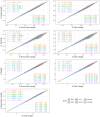Ecological implications of allometric relationships in American alligators (Alligator mississippiensis)
- PMID: 38480785
- PMCID: PMC10937943
- DOI: 10.1038/s41598-024-56798-5
Ecological implications of allometric relationships in American alligators (Alligator mississippiensis)
Abstract
Morphometric allometry, the effect of size on morphological variation, has been of great interest for evolutionary biologist and is currently used in fields such as wildlife ecology to inform management and conservation. We assessed American alligator (Alligator mississippiensis) morphological static allometry across the Greater Everglades ecosystem in South Florida, United States using a robust dataset (~ 22 years) and investigated effects of sex, habitat, and sampling area on morphological relationships. Regression models showed very strong evidence of a linear relationship between variables explaining equal to or above 92% of the variation in the data. Most trait-size relationships (8 out of 11 assessed) showed hyperallometry (positive allometry) with slope deviations from isometry between 0.1 and 0.2 units while the other three relationships were isometric. Sampling area, type of habitat, and in a lesser extent sex influenced allometric coefficients (slope and intercept) across several relationships, likely as result of differing landscapes and ecosystem dynamic alterations and sexual dimorphism. We discuss our findings in terms of the biology of the species as well as the usefulness of our results in the context of ecosystem restoration and conservation of the species. Finally, we provide recommendations when using trait-length relationships to infer population nutritional-health condition and demographics.
Keywords: Allometric coefficients; Body condition; Everglades; Management; Morphology; Static allometry; Trait–size relationships.
© 2024. The Author(s).
Conflict of interest statement
The authors declare no competing interests.
Figures



Similar articles
-
Body condition as a descriptor of American alligator (Alligator mississippiensis) health status in the Greater Everglades, Florida, United States.PLoS One. 2023 Nov 30;18(11):e0295357. doi: 10.1371/journal.pone.0295357. eCollection 2023. PLoS One. 2023. PMID: 38033092 Free PMC article.
-
Alligators in the big city: spatial ecology of American alligators (Alligator mississippiensis) at multiple scales across an urban landscape.Sci Rep. 2020 Oct 6;10(1):16575. doi: 10.1038/s41598-020-73685-x. Sci Rep. 2020. PMID: 33024238 Free PMC article.
-
Mercury distribution in American alligators (Alligator mississippiensis) in Florida.J Zoo Wildl Med. 1997 Mar;28(1):62-70. J Zoo Wildl Med. 1997. PMID: 9226618
-
Adverse encounters with alligators in the United States: an update.Wilderness Environ Med. 2010 Jun;21(2):156-63. doi: 10.1016/j.wem.2010.02.002. Epub 2010 Feb 13. Wilderness Environ Med. 2010. PMID: 20591380 Review.
-
Alligators and Crocodiles Have High Paracellular Absorption of Nutrients, But Differ in Digestive Morphology and Physiology.Integr Comp Biol. 2015 Dec;55(6):986-1004. doi: 10.1093/icb/icv060. Epub 2015 Jun 9. Integr Comp Biol. 2015. PMID: 26060211 Review.
Cited by
-
Habitat Integrity Challenges for the Chinese Alligator Amid Land Occupation by Human: Pathways for Protection.Ecol Evol. 2025 Mar 10;15(3):e71113. doi: 10.1002/ece3.71113. eCollection 2025 Mar. Ecol Evol. 2025. PMID: 40065923 Free PMC article.
-
Size-dependent effects of the intestinal microbiota in juvenile Chinese alligators: implications for species protection.Front Zool. 2025 Jul 29;22(1):15. doi: 10.1186/s12983-025-00572-4. Front Zool. 2025. PMID: 40731003 Free PMC article.
References
MeSH terms
LinkOut - more resources
Full Text Sources

